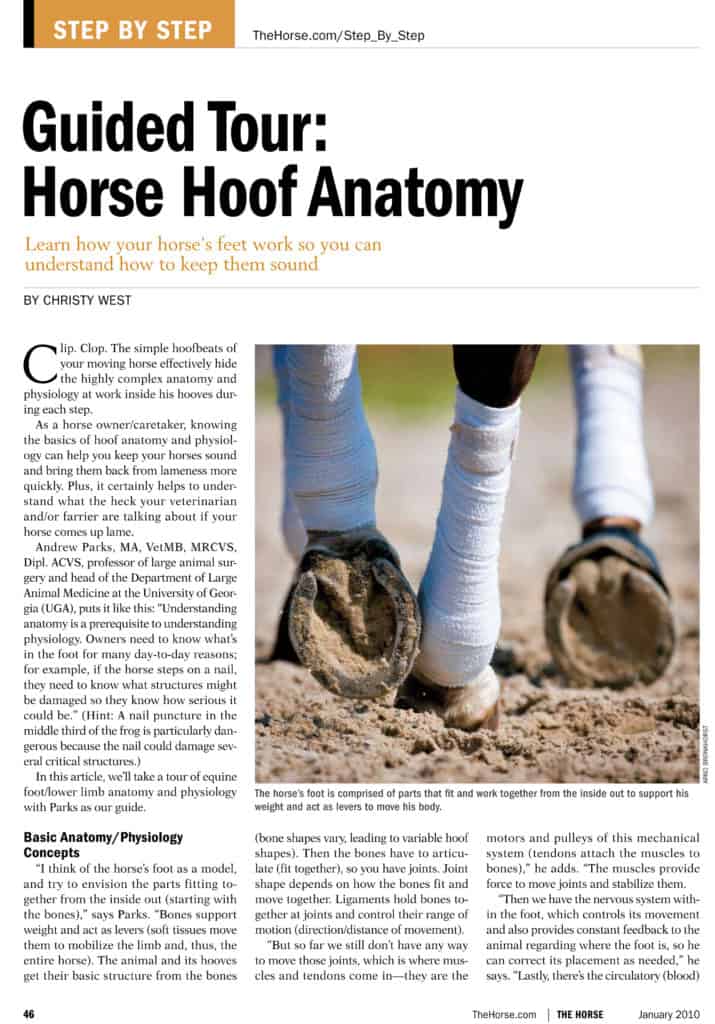
Guided Tour: Horse Hoof Anatomy
The simple hoofbeats of your moving horse effectively hide the highly complex anatomy and physiology at work inside his hooves during each step.

The simple hoofbeats of your moving horse effectively hide the highly complex anatomy and physiology at work inside his hooves during each step.
Newborn foals can be susceptible to many viral and bacterial infections. One example is the unique susceptibility of young foals to Rhodococcus equi, a common cause of bronchopneumonia.

Knowing how the hoof is built and what it is capable of can help you understand what it needs to stay healthy and recover if compromised.
Guttural pouches are more than just ill-defined air-filled vats located somewhere in the horse’s head, said Julie Fjeldborg, DVM, PhD, an associate professor in the department of large animal sciences at the University of Copenhagen, Denmark, during the 11th Congress of the World Equine Veterinary Association, which was held Sept. 24-27, 2009, in Guarujá, Sao Paulo, Brazil.

If the horse’s gastrointestinal (GI) tract were a highway, no self-respecting engineer would take credit for its design. Take a trip along the highway of the equine GI tract to learn more about how your horse digests his food.
Is it possible genes that become shorter as horses age could be the key to how well that animal’s immune system works?
I purchased my Thoroughbred gelding when he was 5 years old. Within the next two years we were doing really
Learn how to keep splints (bony lower leg swellings) from becoming permanent blemishes or problems that interfere with a horse’s athletic career.

This is exemplified by the respiratory and cardiovascular systems, which must get up to “speed,” often from a standing start, to ensure that sufficient oxygen is delivered to the working muscles to allow them to continue to function optimally.
What would be the best avenue to take to prevent too much scar tissue from forming and limiting muscle use?
Researchers examined the effects of uneven feet on equine performance and linked this to other faults.
The foal’s immune system is almost a blank slate at birth; researchers are figuring out how to best protect horses as they grow.

During the 2008 AAEP Convention experts discussed anabolic steroids, therapeutic medications, aortic-iliac thrombosis(AIT), airway inflammation, polysaccharide storage myopathy (PSSM), and the benefits of endoscopic diagnosis of airway problems during exercise.
Women aren’t the only ones suffering from decreased bone density and bone mass loss–horses in Central California have experienced a systemic osteoporotic disorder. Equine bone fragility syndrome, a systemic osteoporotic (characterized by a decrease

Dr. Paul Lunn discusses immunity’s role in the neurologic form of equine herpesvirus-1 at a 2007 meeting hosted by the C.L. Davis Foundation and the American Association of Veterinary Laboratory Diagnosticians.

One of the biggest debates about equine herpesvirus meyloencephalopathy (the neurologic form of EHV-1) is whether there is a single mutant strain in circulation that causes EHM. We will discuss the roles of pathogenesis, prevention and protection.
Stay on top of the most recent Horse Health news with
"*" indicates required fields